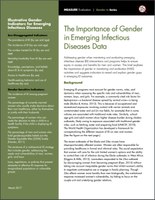It’s Time for a New Question in Disease Outbreaks
 Brittany Iskarpatyoti, MPH, research associate and gender advisor for MEASURE Evaluation
Brittany Iskarpatyoti, MPH, research associate and gender advisor for MEASURE Evaluation
Diseases are not blind to gender. Many of them biologically prefer or are more in contact with one sex over another: be it male rice field workers occupationally exposed to leptospirosis[i] or school-age girls exposed to schistosomiasis when fetching water.[ii]
Unfortunately, the systems to monitor and respond to diseases continue to overlook these gender-based vulnerabilities even as the incidence of emerging infectious diseases has risen significantly over the last fifty years.[iii] Within just the last decade, the world has been shaken by severe acute respiratory syndrome — SARS — in East Asia, Middle East respiratory syndrome — MERS — in the Middle East, Ebola in West Africa, and Zika in South America. Global health security experts agree that one thing is certain: another outbreak is likely. And it’s untrue that the only questions are when and where. The additional question is: who?
Gender data can help determine the extent to which emerging infectious disease responses and programs contribute to or are affected by gender inequities. Yet, systems to monitor and respond to emerging infectious diseases are woefully unprepared on that score. And while there has been recent international interest in both gender data[iv] and epidemic preparedness,[v] these interests do not often overlap.
This month, the World Health Organization announced another outbreak of Ebola in the Democratic Republic of the Congo. And the global community has mobilized to focus public health response on control and treatment, leaving social problems — including gender inequities — to be addressed when the outbreak is over. This may seem understandable in an emergency, but I’d argue that after an outbreak, any gender analysis is purely academic.
For example, in the space of 18 months during the Ebola outbreak in West Africa, the diversion of routine health resources led to a statistically significant decline of reproductive, maternal, newborn, and child health clinical visits[vi] and an overall increase in maternal mortality.[vii] Additionally, the social expectation that women will care for the sick limited women’s options and their ability to control their risk of infection.[viii] Similar barriers were noted after Haiti’s 2010 Cholera outbreak.[ix] When Zika hit South America, lawmakers discouraged women from becoming pregnant[x] without considering inequitable gender norms that inhibit women’s ability to negotiate contraceptive use or engage in family planning.
MEASURE Evaluation, a project funded by USAID, is working to understand the intersection of gender and infectious disease. A new brief, The Importance of Gender in Emerging Infectious Disease Data, explores the importance of gender in monitoring and evaluation and suggests indicators that can reveal and explain gender gaps in emerging infectious disease outcomes. By creating a dialogue and shared understanding of the gendered inequity of public health emergencies, we could target response to the next outbreak so those affected can survive the crisis without compounding existing inequities.
This post is republished with permission from Science Speaks.
[i] Skufca, J. & Arima, Y. (2012). Sex, gender and emerging infectious disease surveillance: A leptospirosis case study. Western Pacific Surveillance and Response Journal, 3(3) 37–39. Retrieved from https:// www.ncbi.nlm.nih.gov/pubmed/23908921
[ii] USAID. Schistosomiasis. Retrieved from https://www.neglecteddiseases.gov/usaid-target-diseases/schistosomiasis
[iii] Jones, K. E., Patel, N. G., Levy, M. A., Storeygard, A., Balk, D., Gittleman, J. L., & Daszak, P. (2008). Global trends in emerging infectious diseases. Nature, 451(7181), 990-993.
[iv] Temin, M., & Roca, E. (2016). Filling the Gender Data Gap. Studies in Family Planning, 47(3), 264-269.
[v] Seifman, R. (2017). Making the Coalition for Epidemic Preparedness Innovations (CEPI) more effective. The Lancet Global Health Blog. Retrieved from http://globalhealth.thelancet.com/2017/03/17/making-coalition-epidemic-preparedness-innovations-cepi-more-effective
[vi] Barden-O’Fallon, J., Barry, M. A., Brodish, P., & Hazerjian, J. (2015). Rapid assessment of Ebola-related implications for reproductive, maternal, newborn and child health service delivery and utilization in Guinea. PLOS Currents Outbreaks.
[vii] Mullan, Z. (2015). The cost of Ebola. The Lancet Global Health, 3(8), e423.
[viii] Diggins, J. & Mills, E. (2015). The pathology of inequality: Gender and Ebola in West Africa. Institute of Development Studies. Retrieved from http://www. ids.ac.uk/publication/the-pathology-of-inequality-gender-and-ebola-in-west-africa
[x] Dyer, O. (2015). Zika virus spreads across Americas as concerns mount over birth defects. British Medical Journal, 351. Retrieved from http://www.bmj.com/ content/351/bmj.h6983













